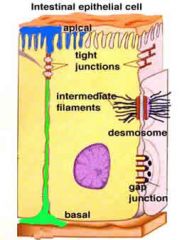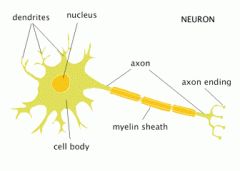![]()
![]()
![]()
Use LEFT and RIGHT arrow keys to navigate between flashcards;
Use UP and DOWN arrow keys to flip the card;
H to show hint;
A reads text to speech;
71 Cards in this Set
- Front
- Back
|
fourprimary types of tissues |
1.Connective tissue |
|
|
ConnectiveTissue functions |
1. Forms metabolic and structural connections between other tissues |
|
|
Ground substance |
1. The medium through which cells exchangenutrients and waste with the blood stream |
|
|
ConnectiveTissue Components |
•Extracellularmatrix |
|
|
Extracellular matrix composed of |
–Extracellular fibers |
|
|
Extracellular fibers consist of |
Collagenousfibers Reticularfibers Elasticfibers |
|
|
Collagenous fibres |
–Strong,thick strands of collagen (a fibrous protein) |
|
|
Reticularfibers
|
–thin,delicate, branched networks of collagen –Providesupport for highly cellular organs: endocrine glands, lymph nodes, spleen, bone marrow, and liver –Alsofound around: blood vessels, nerves,muscle fibers and capillaries |
|
|
Elasticfibers |
–branchednetworks composed of: primarily proteinelastin –Composedof coiled bundles of microfibrils –Occurin tissues commonly subjected to stretching ie: vocal cords, lungs, skin, and walls of bloodvessels |
|
|
CellTypes |
FixedCells TransientCells |
|
|
Fixed cells involved in |
the production & maintenance of the matrix |
|
|
fixed cell types and involvement |
–“blasts”: osteoblasts (make bone) |
|
|
Transient cells |
involved in the repair and protection oftissues |
|
|
transient cell types |
–Leucocytes:WBC’s |
|
|
Looseconnective tissue |
–Areolar –Adipose –Reticular |
|
|
•Dense connective tissue:types |
–Denseregular –Denseirregular –Elastic |
|
|
AreolarConnective Tissue |
•Looseconnective tissue |
|
|
AdiposeTissue |
•Areolartissuein which adipocytespredominate •Highlyvascular |
|
|
ReticularConnective Tissue |
•Networkofthin reticular fibers. |
|
|
DenseRegular Connective Tissue |
•Composedof tightly packed, parallelcollagen fibers |
|
|
DenseIrregular Connective Tissue |
•Composedprimarily of collagen fibersarrangedin thick bundles |
|
|
ElasticConnective Tissue |
•Primarilycomposed of elastic fibers |
|
|
SpecializedConnective Tissues |
Cartilage |
|
|
Cartilage types |
–Hyalinecartilage |
|
|
Cartilage |
•Location:Injoints and the ear, nose and vocal chords |
|
|
HyalineCartilage |
•Most common type of cartilage foundinthe body |
|
|
ElasticCartilage |
•Containselastic fibers in densebranchingbundles |
|
|
Fibrocartilage |
•Usually found merged with hyaline cartilageanddense connective tissue |
|
|
Bone |
•Matrix is a combination of organic collagenfibers and inorganiccalciumsalts •Cells: –Osteoblasts:manufacture the fibers that are part of the matrix-Lacunae and canaliculi are created as the osteoblasts manufacture the bonymatrix–––Osteocytesreside in the lacunae, maintain bone structure–––Osteoclastswill break down bone when necessary |
|
|
Blood |
•Matrix: |
|
|
MucousMembranes aka mucosae |
•Location:line organs with connections to the outside environment (mouth, intestines,nasal passages etc) •Maycontain goblet cells or multicellular glands-can produce large quantities of mucous (goblet)-mucus consists primarily of water, electrolytes and protein mucin |
|
|
SerousMembranes (serosae) |
•Location: -line the walls and cover organsof the body cavities: |
|
|
CutaneousMembrane |
•Outerlayer of stratifiedkeratinized squamous epithelium: epidermis |
|
|
SynovialMembranes |
•Location: line the cavities of joints |
|
|
MuscleTissue
|
•Composedof actinand myosin fibers(complex proteins) which act together to cause contraction
•Threetypes of muscle tissue: –skeletal –smooth –cardiac |
|
|
SkeletalMuscle |
•Longcellsthat contain hundreds of nucleiand mitochondria |
|
|
SmoothMuscle
|
•Composedof small, spindle-shaped cells that lack striations (non-striated) |
|
|
CardiacMuscle |
•Location:walls of the heart |
|
|
EpithelialTissues |
•Sheetsof cells that cover and line other tissues•Protectunderlying tissues and may act to filter biochemical substances |
|
|
Characteristicsof Epithelia
|
•Eachepithelial cell has an apical surface and a basal surface |
|
|
CellularAttachments •Threemajor types of intercellularjunctions: |
1. tight junctions |
|
|
TightJunctions |
•Formedby the fusion of the outermost layers of the plasma membranes of adjoiningcells |
|
|
Desmosomes |
•Mechanical coupling formed by:filaments that interlock with one another |
|
|
GapJunctions |
•Tubularchannel proteins (connexons)that extend from the cytoplasm of one cell to the cytoplasm of another |
|
|
BasementMembrane |
•Function: |
|
|
SurfaceSpecialization •Surfacesof epithelial cellsvary dependingon where they are located and what role they play in the function of the tissue 4 types |
–Smooth:where no specialization is needed –Keratin:waterproofing and strength |
|

|
tight junctions |
|
|
Classificationof Epithelial Tissue |
•Numberof layers of cells: – keratin |
|

|
|
|
|
SimpleSquamous Epithelium |
•Structure:fragile and thin |
|
|
SimpleCuboidal Epithelium |
•Structure: |
|
|
SimpleColumnar Epithelium |
•Structure: |
|
|
StratifiedSquamous Epithelium |
•Structure:multilayer of flat cells |
|
|
StratifiedCuboidal Epithelium |
•Structure:usually two layers of cuboidal cells •Function:protects underlying tissues •Location:found primarily along the large excretory ducts (salivary & mammary glands) |
|
|
StratifiedColumnar Epithelium |
•Structure:several layers of cuboidal cells with a columnar layer on top |
|
|
PseudostratifiedColumnar Epithelium |
•Structure:single layer of columnar cells that appear to be stratified because the cellnuclei are found at different levels across the length of the tissue |
|
|
TransitionalEpithelium |
•Structure: Stratified epithelium with a basal layerofcuboidal or columnar cellsand asuperficiallayerof cuboidalorsquamous cells |
|
|
GlandularEpithelium
|
Groupsof cells that manufacture and discharge a secretion
|
|
|
Classification of glands |
1.Presenceor absence of ducts |
|
|
EndocrineGlands |
•Partof a complex, biochemical network known as the endocrine system |
|
|
ExocrineGlands
structure |
dischargesecretions via ducts directly into local area- the secretions eventually leavethe body
|
|
|
multicellular exocrine glands |
•most exocrine glands
–salivaryglands –sweatglands –mammaryglands |
|
|
unicellular exocrine glands |
•Gobletcells |
|
|
exocrine glands ducts |
Simple: main duct is unbranched
Compound: main duct is branched |
|
|
exocrine glands Shape of secretory portions |
Tubular: secretory cells form a long channel of even width
Alveolar (or acinar): secretory unit forms a rounded sac Tubuloalveolar, or tubuloacinar: secretory units possess both tubular and alveolar qualities |
|
|
ExocrineGlands
Type of secretion produced: |
•Seroussecretions
–watery –contain a high concentration of enzymes •Mucoussecretions – thick, viscous –Composedof glycoproteins. |
|
|
NervousTissue |
•Location:found in the brain, spinal cord and peripheral nerves |
|

Neurons
|
•Longest cells in the body; threeprimaryparts:
–Perikaryon(soma): the cell body; contains thenucleus –Dendrites: short cytoplasmc extentions(from the soma); receive inpulses –Axons: long, single extension; conducts impulsesaway from the cell body |
|
|
Neuroglial cells
|
–Supportthe neurons
|
|
|
Typesof Neurons |
•Sensoryneurons: nerve cells that carry information(nerve impulses) toward the CNS •Motorneurons: nerve cells that carry information away from the CNS
•Associationneurons: nerve cells that compose the CNS ( brain and spinal cord) |
|
|
Typesof Nerves
|
•Sensorynerves: bundles of sensory neurons that carry information(nerve impulses)toward the CNS |

